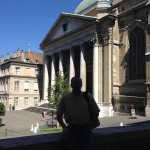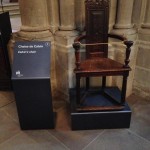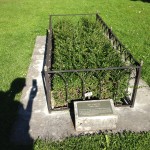
Our driver picked us up today at our hotel in Beaune, France at 9:00 a.m., and we began our two-hour drive across the border into Switzerland. The last 30 minutes of the drive was stunning.
We entered a long tunnel cut through a mountain, exiting on the other side on a highway suspended high above a valley surrounded by mountains, then into another tunnel and out onto another elevated highway, repeating the cycle until finally we were emptied into a plain looking down on the city of Geneva.
What’s surprising is how small Geneva is relative to its reputation. The population is just under 200,000, and from a distance it looks like a small town on the lake, but its prominence today and during the Reformation far exceeds its physical size.
There was a difference between Martin Luther’s approach to reformation and that of Calvin and the other Swiss Reformers. Luther disregarded only those Catholic practices and beliefs that contradicted the Bible, while Calvin disregarded any Catholic practices not specifically supported by the Bible. That is why Lutheran churches are much more like Catholic churches than say, Presbyterian churches.

What Luther and Calvin agreed upon was that salvation was by faith alone in Jesus, not by works. This understanding had been lost over more than a milennium of multiplying religious rituals and superstitions about saints, which became like accumulated dirt on a window through which the true object of worship—Jesus—could no longer be seen.
The Reformers did not merely clean the window; they shattered the glass, allowing the revelation of Jesus and the truth of his death and resurrection to shine forth in all its clarity. Luther and Calvin did so at great personal cost, but in doing so, they changed the world and reestablished the foundation for the kingdom of God.
Calvin was born in France, educated as a lawyer and as a theologian. By the time he finally settled in Geneva in 1541 he had already been born again and had written his first edition of his Institutes of the Christian Religion (at age 26). He was the pastor at the Saint Pierre Cathedral in Geneva from 1541 until his death in 1564. During that time, Geneva became the Rome of the Reformation and a successful experiment in how a city can be transformed by the Gospel.

We visited Saint Pierre Cathedral today. It’s noticeably different from the many Catholic churches we’ve seen on the trip in that it lacks much of the ornateness and statues. It’s a beautiful building, but one is not distracted from its purpose by its appearance.
Calvin’s chair, as one can see in the photo I took, is ordinary, not ornate, and certainly not a throne. Calvin recognized Jesus came to serve, and as a pastor, Calvin did the same.
Calvin insisted when he die that he be buried in an ordinary tomb and that his final resting place remain a secret. He wanted to avoid what had happened in the Catholic Church over the years, where mere men had been elevated to a status where theologians were forced to draw apologetic distincitions between “adoration” and “worship” of the saints.
We ended our day with a visit to Calvin’s grave. It’s the traditional spot but it is still a guess whether he is really buried there, and that is probably how he wanted it.
There we stood, 500 years after Calvin’s death, contemplating the man. We did not have the urge to worship him or even adore him. The humility of his life—his church, his chair, and his tomb—led us past Him to the One he worshipped. And that is as it should be. GS
